DT770 Pro (32Ω)
back to Beyerdynamic
back to measurements
home
published: Sept-16-2023
322NO SMOOTHING is applied to the shown plots. Most measurement sites have some smoothing applied which ‘irons flat’ sharp peaks and ‘wiggles’. I do not use smoothing because some info about sound quality is lost when plots are smoothed.
Aside from a small correction of the microphone itself also some correction in the lowest frequencies is applied to the plots to compensate for the perceived loss of bass when using headphones. This is described HERE in more detail.
A ‘horizontal‘ frequency response curve on the shown frequency response plots on this website thus indicates a perceived ‘flat’ tonal signature.
ALL measurements are made with a good SEAL on a flatbed measurement rig.
The shape of your head, bone structure, pad size, pad ‘softness, (compliance), hair or no hair and or wearing glasses may (drastically) change the frequency response of some headphones, so… your personal experience may differ substantially from these plots.
Frequency response (tonal balance) is the most sound-determining aspect of headphones. A horizontal line shows audible neutral response in the plots on this website. Deviations in different severity at different frequency bands have an effect on the sound character.
The bigger the deviation the stronger the effect.
Below an aid to help determining the sound character of headphones with relation to the frequency response.

Beyerdynamic DT770 Pro-32Ω
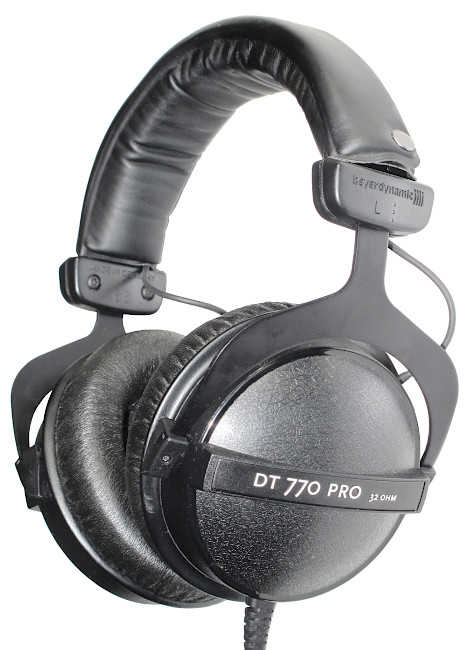
The DT770Pro–32Ω is often used by gamers because of its low impedance and reputation the DT770 series has in studios. It has a quite decent attenuation of outside noises, is comfortable and durable. Replacement parts (headband and pads) are available.
A very sturdy headphone with ancient looks.
The DT770 sells for around prices ranging between € 130.- and € 160.-
It is quite a bit more sensitive (111dB/V) than the higher impedance models so requires less voltage to reach the same volume.
Because of the intended portable use the (non replaceable) cable (1.6m) is shorter than those found on the 80Ω and 250Ω models (3m).
There is a 3.5mm TRS jack with a screw-on 6.3mm adapter. This headphone thus cannot be used on amps with a balanced output.
The pads (EDT 770 S) are comfortable but can get a little sweaty and can easily be replaced. This is needed too as the foam inside and the pleather starts to flake and decay rather sooner than later.
The headband foam as well is easily replaced and just like the are pads available as spare parts.
specifications:
Type: Over ear, closed
Usage: Home, studio
Driver type: dynamic
Pads: replaceable, pleather, regular foam
Collapsible: No
Headphone cup connector: fixed cable
Cable entry: single entry
Cable: straight 1.6m terminated in a gold-plated threaded 3.5mm TRS jack with a 6.3mm adapter
Driver size: 45mm
Inner pad dimensions: depth: 22mm. diameter: 55mm.
Max. power rating: 0.1W
Max. voltage: 1.8Vrms (5Vpp)
Max. current: 60mA
Max. S.P.L.: 116 dB
Impedance: 31 Ω (measured)
Efficiency: 96dB @ 1mW
Sensitivity: 111dB @ 1V
Weight: 270 g. (excl. cable)
Clamping force: medium (3.5N)
Subjective sound description:
The bass is deep and somewhat (tastefully) elevated. The pad bounce (dip around 65Hz) make the bass quality a bit less and the dip around 220Hz makes the bass ‘disconnected’ from the rest.
Mids are good and realistic but lack ‘finer nuances’.
The treble is where things get a little sketchy … or should I say ‘etch-y’. The elevated treble is fine for monitoring where it adds ‘detail’. For music enjoyment, however, it adds too much sibilance and sharpness (8kHz).
measurements
Below the frequency response of the DT770Pro (Left, Right)
Excellent bass extension, Bass response is not very even. The sharp drop above 160Hz makes the bass sound somewhat off as harmonics are relatively too low in level. The dip around 250Hz makes the bass a bit ‘disconnected’ from the rest of the music.
The upper mids (which is the ‘shout’ range) is a bit lower than desirable. The small lift around 2kHz makes the mids have enough clarity. The upper mids dip is responsible for the lack of ‘finer nuances’ in voices.
The biggest problem it has (at least when using it to enjoy music) is the huge treble peak (+15dB at 8kHz) which makes the treble sound extremely sharp and unpleasant.
As closed headphones usually are seal dependent below some measurements of the DT770-32 with the seal broken in various degrees. Perfect seal , seal broken with thick armed glasses flush against the skin, thin armed glasses not resting against the skin near the pad, thin armed glasses not resting against the skin near the pad, pads slightly lifted. 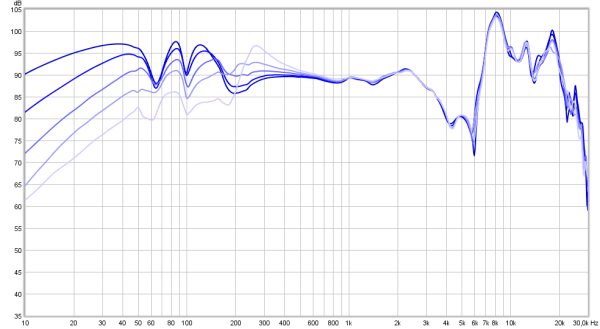 As can be seen a small seal breech will not affect the sound much but when the seal is broken a bit more the bass will disappear. This is very common for the vast majority of closed headphones.
As can be seen a small seal breech will not affect the sound much but when the seal is broken a bit more the bass will disappear. This is very common for the vast majority of closed headphones.
Below the phase response of the DT770-32 (left, right) Slow phase shifts are not very audible. Steep changes in a narrow frequency bands may well be audible. There is some ‘pad bounce’ between 50Hz and 200Hz.
Slow phase shifts are not very audible. Steep changes in a narrow frequency bands may well be audible. There is some ‘pad bounce’ between 50Hz and 200Hz.
From 6kHz to 9kHz there are substantial (almost 180° so in opposite phase of the rest of the frequencies). Phase shifts variances in a narrow frequency band which could be audible (lowering sound quality) and these amounts qualify.
compared to DT770-250
The DT770-250Ω has velour pads (EDT 770 V) and is 10dB less sensitive so the 32Ω version plays twice as loud as the 250Ω version at the same volume control setting. The drivers differ and the pads differ resulting in a different sound. Both have elevated bass, but in a different amount and both have an upper midrange dip. Both also have a treble peak but different. Both are too ‘sharp’ sounding for music reproduction. Below the DT770 32Ω versus 250Ω.
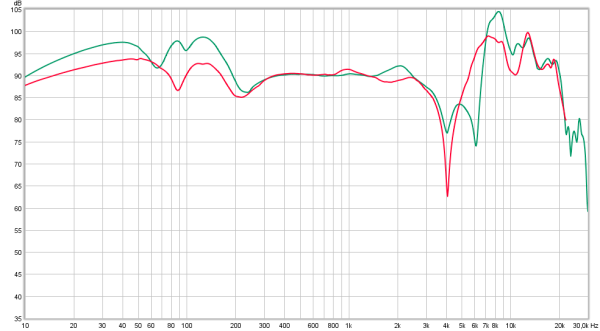
Below the DT770-32 compared to 15 other (closed) headphones.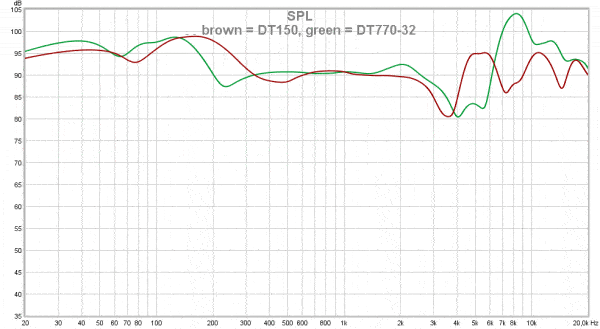
Below the DT770-32 compared to another set of 14 other (closed) headphones.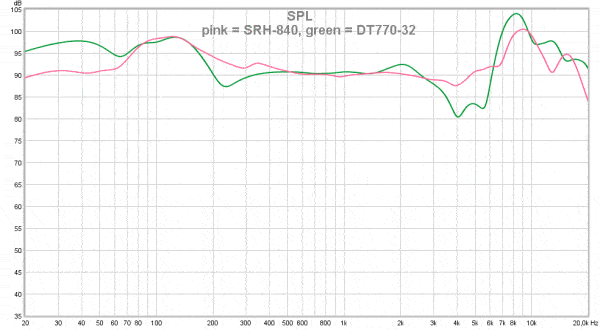
output resistance / damping-factor
As this is a closed dynamic headphone the frequency response can be amplifier output resistance dependent when certain higher output resistance amplifiers are used.
Instead of showing impedance plots, which are hard to ‘read’ when it comes to assessing the tonal balance change in the real world, the HP5 is measured via a few different resistance outputs (0.2Ω, 10Ω, 32Ω and 120Ω). On a higher output resistance amplifier the output level will be lower of course due to voltage division. To compensate for this the amplifier is turned up to the same level (13.3dB for 120Ω at 1kHz in this case at max. volume setting).
This way the plots are overlaid and it is easier to see how the tonal balance changes. 
Despite the low impedance there is only a small increase in lower bass. A higher output resistance (some interfaces, tube amps or receivers/integrated amps) thus will not change the sound too much.
distortion
Below the distortion measurements of the DT770-32 (right channel) at 85dB SPL @ 1kHz. Note that around 150Hz the SPL is around 94dB SPL.

Below the same distortion plot but with the vertical scale in percentages instead of level differences.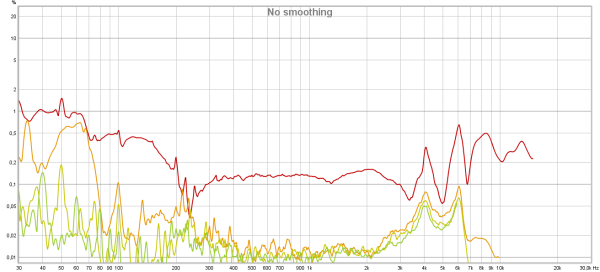
Distortion at 98dB SPL (around 50 Hz) is low for this driver size (1%) and is mainly 2nd and 3rd harmonic indicating some compression is going on.
The distortion above 200Hz is good. Above 3kHz there appears to be an increase in distortion but this is only because it is relative to the signal level which is 10dB lower so that’s why it only appears to have an increase in distortion.
The 2nd harmonic distortion above 200Hz is may be lower than shown as limits of the test rig are around 0.15%.
Linearity
To see how severe the compression is the DT77032 is measured 4 times. Once at 70dB, 80dB, 90dB and 91dB SPL (@ 1kHz). When the traces are overlaid with the 90dB trace and have the same shape then there is no compression visible. Note: the 2dB/div scale. Some compression already starts to occur above 80dB (bass level is 89dB there). 
90dB in the bass is NOT very loud. 90dBA average noise levels ARE quite loud.
There is not much compression at 90dB SPL in the bass but these Beyerdynamic drivers are known to not being able to handle much higher SPL in the bass.
time domain
Below the CSD of the DT770-32 (left and right are overlaid). The driver has a resonance around 8kHz. It does appear to be well damped as it is quite short lived.
The driver has a resonance around 8kHz. It does appear to be well damped as it is quite short lived.
Below the spectrum plot of the DT770-32 (left channel).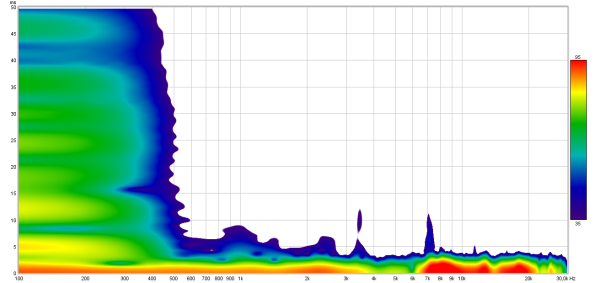 The lower mids linger on a bit longer than desirable.
The lower mids linger on a bit longer than desirable.
Below the group delay plot of the DT770-32 with a perfect seal (left, right)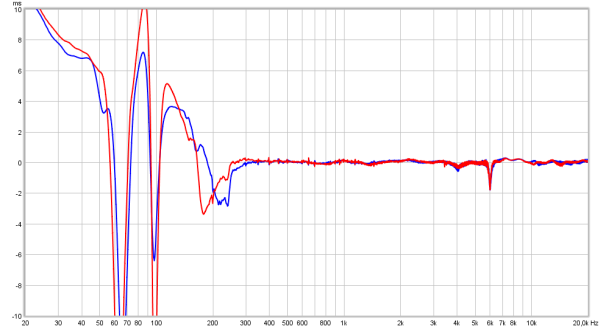 There is a lot of ‘pad bounce’. Between 50Hz and 100Hz. Also up to 300Hz there are indications of resonances. A resonance at 6kHz is also visible.
There is a lot of ‘pad bounce’. Between 50Hz and 100Hz. Also up to 300Hz there are indications of resonances. A resonance at 6kHz is also visible.
The step response of the DT770-32 (left, right) The initial rise comes up 6dB ‘short. The slow rise in the first 1.5ms shows the excess ‘warmth’ and bassy character. The hardly sloping horizontal part past 1.5ms shows the very good subbass extension.
The initial rise comes up 6dB ‘short. The slow rise in the first 1.5ms shows the excess ‘warmth’ and bassy character. The hardly sloping horizontal part past 1.5ms shows the very good subbass extension.
pads
Below the stock DT770Pro (right channel) and with the felt ring removed (see picture above). When filling the cup with wool the bass got lower and better but the dip became deeper and wider again.
Adding wool when the felt ring was there resulted in slightly more balanced lows but not in a higher quality though.
To remove some of the piercing treble/sibilance I tried 3 mm thick wool felt in front of the driver.
Below the results of the DT770Pro with 3mm thick wool-felt vs stock in Replacing the foam disc in front of the driver with a 3mm felt disc (so no hole in the middle) results in slightly elevated bass and somewhat, but not enough, reduction of the treble.
To lower the treble effectively a passive filter (or EQ) is best.
treble peak filter
Below the schematic for the DT770-32Ω filter. The filters for the 80Ω, 250Ω and 600Ω versions differ and can be found here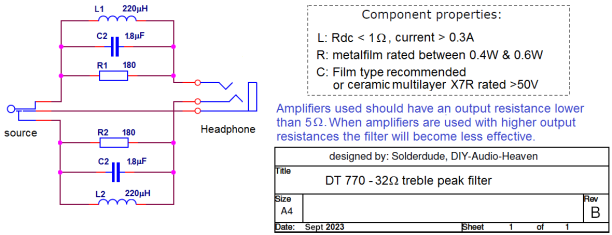
This passive filter goes between the amplifier and headphone cable and completely removes the sharpness. Stock, with filter.

Treble reduction is also possible with toilet paper but the effect is most effective at the highest frequencies and less so at 8kHz. It also affects the dip at 5kHz.
stock, 1 ply (of a sheet of 3-ply toilet paper), 2 plies and 3 plies.
While toilet paper (between the driver and foam disc) lowers the treble it also lowers treble extension. Optimal effects were created using the passive filter + 1 ply of toilet paper.
This makes the treble sound nice and refined.
pads
The 32Ω version comes with pleather pads (EDT770S). Below some experiments with other Beyerdynamic pads such as the familiar grey EDT770V pads and the pleather and velour DT1770 pads.
Below the EDT770S (pleather) versus the EDT770V (velour)pads.

Below the EDT770S (pleather) pads versus EDT1770D (pleather) pads
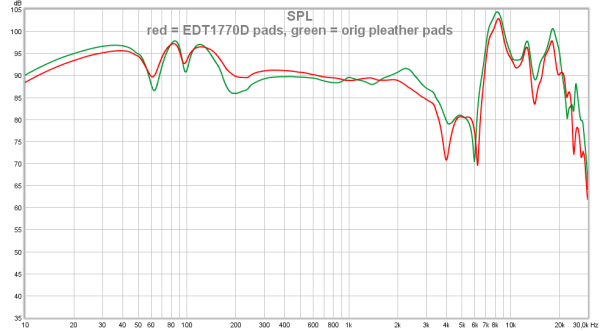
Below the EDT770S (pleather) pads versus EDT1770 (velour) pads.

Some people believe the DT770 pads are the same ones used on the DT880 and DT990. They look and feel the same but have quite different intentional ‘leakage’ in the lower frequency range.
So it is important not to use DT880/990 pads on the DT770 because bass response will be severely compromised as shown below.

Bass port
 Just above the hinges there is a small port which affects bass response.
Just above the hinges there is a small port which affects bass response.
It can be partially closed and this will affect the bass response.
For the bass response to significantly drop about 3/4 of the port must be blocked.
This, however, also increases distortion in the lowest frequencies a bit (but not very much).
Sealing the hole completely totally kills the bass. So while it is possible to lower bass levels using this trick (leaving 1/4 of the hole open and blocking 3/4 using black tape) it will be hard to do this exactly the same on both sides. A little more or less blocking can result in a quite different bass response between L and R cups.
Below: Port fully open (stock), port 1/2 blocked, port 3/4 blocked, port 7/8 blocked, part completely blocked.

Another way of reducing bass (aside from using velour pads or partially blocking the port) is to fill the cups with some fiberfill (synthetic wool used in pillows for instance).
Below the effect using fiberfill vs stock.
This increases bass quality a little and lowers the bass response a few dB.
modifications
This headphone lends itself to some modifications which increases the usage as a HiFi headphone.
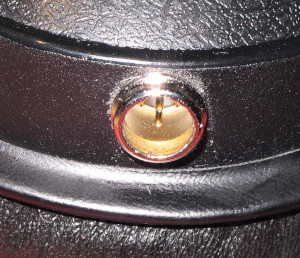 While not really needed (as it is 32Ω) this headphone is now equipped with a 4-pin mini XLR plug and thus has a replaceable cable. Depending on the used connector it can be connected to all headphone amps and cable lengths can be made.
While not really needed (as it is 32Ω) this headphone is now equipped with a 4-pin mini XLR plug and thus has a replaceable cable. Depending on the used connector it can be connected to all headphone amps and cable lengths can be made.
The second modification is to make the backside less reflective. This is done with some felt in the cup. Also the cup is now filled with synthetic wool.
The most important modification is the treble peak filter that is installed inside. This combined with 1 ply of toilet paper makes the sharp treble disappear and now sounds excellent in the treble.
Below the difference between stock and modified (with original pleather pads)
 The mains changes are the removal of the dip around 200Hz and the treble peak.
The mains changes are the removal of the dip around 200Hz and the treble peak.
Comfort is increased by fitting the familiar grey EDT770V pads which has a small acoustical effect as well. Stock (pleather) vs. modified with EDT770V velour pads.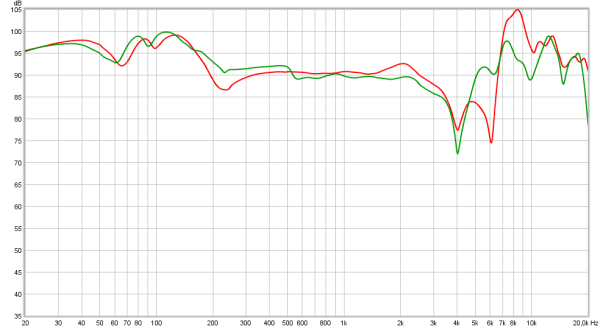
The 200Hz dip is removed (integrates bass better with the rest), clarity is lowered slightly (the small hump at 2kHz) and the dip at 6kHz is gone, also the treble quality is greatly improved.
The overall character (elevated bass + treble) is still there but the sound quality is improved and there is no sharpness any more making it a more enjoyable listen and has a removable cable.
conclusion
The Beyerdynamic DT 770 / 32Ω is intended for portable and desktop duties driven from low power devices. Due to its shorter (1.5m) cable, lower impedance and higher sensitivity this headphone can be used with PC’s, tablets, interfaces, phones.
It is a sturdy headphone that can take a beating and pads, foam, and headband padding is available as spare parts.
The cable is not replaceable and this headphone thus also cannot be used with balanced equipment.
This headphone is also great for monitoring purposes. Because of the pleather pads it can get sweaty a bit when wearing it in warmer environments for longer periods.
They are not suited for a final mix nor to apply EQ to individual tracks.
As a Hi-Fi headphone it lacks ‘finesse’ is a bit ‘off’ in the mids (but not in a bad way) and has way too much treble resulting in sharpness.
While seemingly having an impressive bass the quality of bass is lacking somewhat when compared to better headphones in this aspect.
There are also 80Ω and 250Ω versions. These 2 models sound somewhat different because of their different pads (velour) and require a higher drive voltage so may need some amplification and have different cables and lengths.
As far as decent sounding closed headphones is concerned the DT770 is a good choice with some EQ/filtering.
